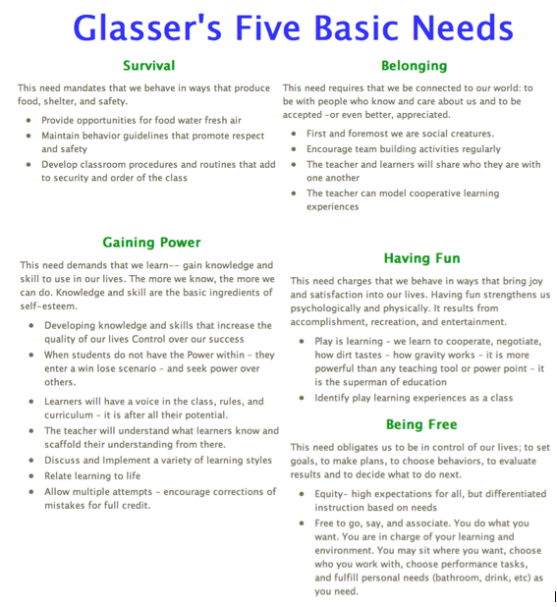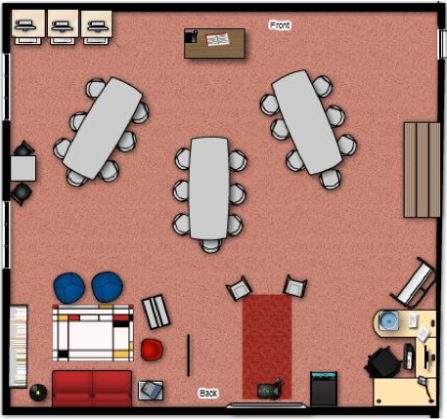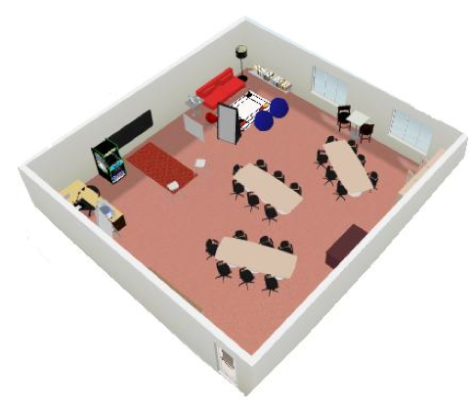Classroom Redesign Project
”Design is not just what it looks like and feels like. Design is how it works.”–Steve Jobs
This week our goal is to use SketchUp to redesign our classroom, integrating experience design into our new and improved learning space. After watching a short video clip where Tedde van Gelderen explains Experience Design, I had a much better hold on how to complete this week’s task. In fact, watching the video made me realize that I have spent and continue to spend a lot of time planning and learning in accordance with Experience Design; I had just never heard it called Experience Design. In short, Tedde (2009) describes how an experience is a holistic view of how people go through a set of events in time. He stresses the importance of time, flow (or order of events), interaction [with the environment and people], and emotion and how they all play an important role in the overall experience—the experience is funneled by human senses triggered by what we see, touch, taste, hear, and smell. This theory resonates with something one of my classes came up with last year. They decided we should have a “hustle and flow” classroom. That is, our classroom should allow for diverse learning experiences to occur simultaneously…but that there should be “flow” or rhythm to the learning occurring at all different levels, kind of like how various instruments come together to make a beautiful composition. They decided that it may look like chaos to someone who walks in and sees different types of learning occurring all around the classroom, but that if that person sticks around they will see the “hustle” or efficient learning occurring with a natural “flow” or progression of organized activities that allow for multiple perspectives and learning styles. Moreover, I learned that Third Teacher+ & Edutopia just announced a new project called “Remake Your Class.” I watched a short video clip about the project. It reminded me of the TV show “Flip This House.” The group goes through a classroom and evaluates the learning space in accordance with the teaching style and teaching goals. The goal is to match the learning space with the values by identifying what works and what could work better. With the Design Experience and this short clip in mind, I began recreating my learning space.
I tried to be realistic while creating, although I know I wasn’t giving restrictions. I tried to follow the re-design process they did in the “Remake Your Class” clip by identifying what works and what could work better. Since I currently have one of the tiniest classrooms, if not he tiniest, I did allow myself to have a bigger classroom with more resources that I currently have. My goal has always been to create a classroom atmosphere that is both encouraging and stimulating, that develops a learning climate that supports thought and exploration and where the students feel secure and confident to take risks. For this reason, I also felt it was important to keep learning theories that support my teaching style in mind while recreating my classroom environment since the two go hand in hand. I tried to make features available in the classroom that align with Glasser’s (1998) Five Basic Needs – water cooler on my desk, various seating arrangements, etc. Below I have created a list of The Five Basic Needs and how they align with classroom re-design and learning goals.
The walls in my classroom will be adorned with learners’ work, learners’ goals, learners’ heroes, learners’ favorite quotes, or anything that reminds them of what they are working for. The learners can add or remove items they place on the walls as they grow and change. We all enter class with an ideal image of who we want to be. Typically, we haven’t achieved this ideal persona. My hope is that the learners can reflect on their personal inspirations as they develop who they want to be. I will also have at least one TV mounted on my wall for the gaming system I will have. In terms of my game collection, I will have leisure games and educational games. I hope to have an arcade game in my classroom for strategy as well. I enjoy game theory and especially liked learning about the learning opportunities the Kinect has to offer in a math classroom.
I had a hard time painting one of the walls in SketchUp, so I made them all white instead (my frustration got the best of me), but I would have my walls a pale yellow color like they are in my current classroom. Believe it or not, but I think the yellow walls I currently have are uplifting and mood altering. They are cheerful. Moreover, I would also use whiteboard paint on the tabletop surfaces. This works exceptionally well in the math classroom. Students can work out problems with their groups, by themselves, or with a teacher right on the table surface. I used whiteboard tables a ton during my undergrad work at Grand Valley and during my student teaching experience in Grand Rapids. We could use different colors to show growth as we progressed through a problem or worked with a partner. I believe whiteboard tables in my new classroom will be just as effective as they were in my previous experiences. The tables will support the social interaction and the interaction with the learning environment itself. Working on the tables will probe discussion and inquiry as learners explore mathematical concepts with others around them.
Moreover, I would have more permanent resources available in my classroom. Presently, we have a math computer cart that I have in my classroom twice a week; however, in my new classroom, there will be computers available at all times. There will be a stationary computer station as shown, as well as a math laptop cart that stays in my classroom at all times. Moreover, there will be a library with an assortment of books available for pleasure reading and for learning content, which provides balance. The library will have a sitting area with different light options. This area can be used for but not limited to group work, studying, or reading. Near the library you may notice a fish tank. I would like to bring the idea of classroom pet back into 21st century education. Fish are low maintenance and I believe a classroom pet would bring positive energy into the learning environment. In my math class we could chart the fishes growth, feeding times, or other components that relate to the math content we are covering. Aside from educational purposes, a pet requires responsibility and purpose.
The desk arrangement was the most difficult for me. I had to consider what the set-up I currently have says to students about what communication should look like in class. Currently my desks are in two columns with four desks in each row. It isn’t practical in terms of my teaching/learning style and doesn’t support the collaboration I require during learning activities; however, my space is limited and there are only so many arrangements that allow for thirty desks. In my new classroom, the instructional space will have tables. Although I will make various, alternate seating arrangements available so learners can engage in a manner they find comfortable. The learners can choose a beanbag, the couch, the bleachers, stools, or the tables. I set the tables up with 7 chairs; however, since I have a few larger classes, I could add additional chairs if needed. I chose to go with tables because they can be split apart but they also allow for conferencing in groups and provide a large work area. I anticipate some learners will choose an alternate seating arrangement that matches their learning style, though. With tables set up this way the students are able to split into two groups of four if needed. They could turn away from each other or they could split the tables. The table design and layout in my new classroom matches the design of an instructional space at Grand Valley State University that I particularly enjoyed. I felt the design was practical for all sorts of learning activities and was easily altered to accommodate particular needs. During my class at GVSU, the table arrangement supported group work, individual work, and partner work. The arrangement also allowed for all of us in the room to see the information being projected or written at the front of the classroom, which is a struggle I have in my current classroom design. The layout in my redesigned classroom is spacious and allows for students to spread out and for the instructor to move about freely and facilitate learning. Students are allowed to walk around the classroom freely, and this layout allows for movement without distraction. Further, when students are working in groups, there is plenty of room for me to walk around the class conferencing with groups and providing individual attention where it is needed.
Most learners have been well trained on how to adequately behave in a traditional classroom. Consequently, in order for this re-vamped classroom layout to be successful, it will be necessary for me to model appropriate classroom procedures for group work, resource exploration, and learner responsibility. I will not tell my students what to do, but I will show them how effective learning occurs in diverse settings, like the ones I have created in my new classroom model. Most importantly, my redesigned classroom matches my learning goals, my teaching methods, my collaboration expectations and supports learning and understanding. I have created a trusting, safe, and fun learning environment where risks are taken and learning is stimulating and challenging.
For a large-scale project like this classroom redesign to happen, there would need to be several sources of support. Grants could be written for the technology, local businesses could be contacted and asked to donate items such as beanbags or books, and the school, of course, would need to be on board with the changes. Items like the bleachers could be donated from sports stadiums. Parents, students, community members, administrators, and staff members would all need to have an active role in implementing the changes. In accordance with Glasser’s Choice Theory and the students’ 5 Basic Needs, the students would have a large part in creating the specifics in the design to ensure individual and holistic learning needs are met. Like I mentioned previously, the teacher will model how learning occurs in diverse settings and will support students as they establish what an effective learning environment looks and feels like. This process should ensure that each aspect of the redesign serves a purpose and supports desirable behaviors and the types of learning we hope to see occur in the new environment.
The cost of the project would depend entirely on how the project was implemented and the types of materials purchased. The overall goal would need to be considered: will the classroom be redesigned efficiently using resources that are available or are low cost or will it be redesigned using a high scale budget, purchasing top of the line technology and materials. The items available for such a project vary greatly. Consider technology, whether it is a plasma TV or laptop, the price ranges significantly based on the product type and functionality. For example, I would love to have MacBooks for my classroom, but the school could choose to go with netbooks instead to lower costs. Either computer would be effective for what my students would be using it for. Things like tables, chairs, and whiteboards are easily budgeted within most districts, so those items shouldn’t be a problem. However, if I would like nice chairs, I may have to seek additional resources. Like I mentioned previously, community businesses may be able donate items or funds for such materials, which would help lower costs significantly. Or, fundraising and grant writing could be done to lower costs for materials as well. There are a lot of small things to consider when taking on a re-design project, from lighting to paint colors, each aspect should be considered in terms of how it will support learning and collaboration in the new space.
Finally, a project like this would probably have to occur over time. Changes would likely be implemented as funds or materials became available. However, depending on the situation, a school district could potentially choose to put all the changes into play over summer vacation or a holiday break during the school year. Typically these types of changes don’t happen overnight. The time frame for the project is directly related to the scale in which the changes are being made and the funds that are available: big changes will require more time and money. Realistically, in the district I work, technology would be purchased and replaced over time; it could be months or years. Lower scale projects like painting would occur much faster over a long weekend or holiday break. Although, I could apply to be a part of The Third Teacher+ & Edutopia’s new project and have my classroom remade that way. A girl can dream 🙂
Resources
Glasser, W. (1998). Choice theory: A new psychology of personal freedom. [Print]. New York: Harper Paperbacks.
van Gelderen, T. (2009). Tedde van Gelderen on experience design. [Video File]. Retrieved from http://www.youtube.com/watch?v=BB4VFKn7MA4&feature=youtu.be


